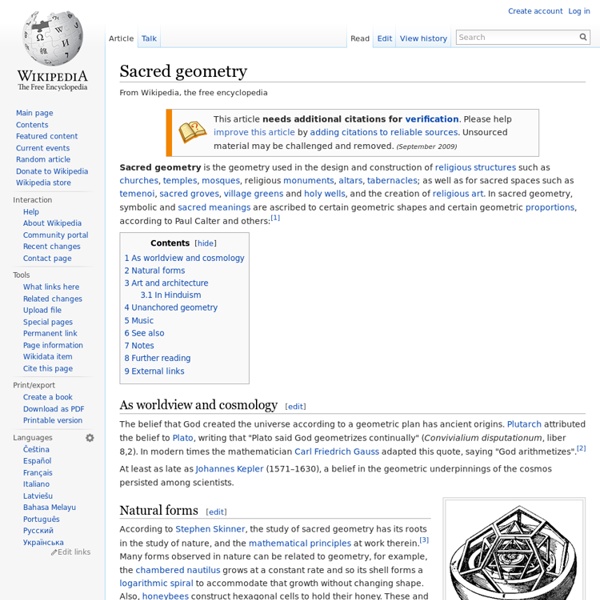Ezine
Sacred Geometry Sacred geometry involves sacred universal patterns used in the design of everything in our reality, most often seen in sacred architecture and sacred art. The basic belief is that geometry and mathematical ratios, harmonics and proportion are also found in music, light, cosmology. This value system is seen as widespread even in prehistory, a cultural universal of the human condition. It is considered foundational to building sacred structures such as temples, mosques, megaliths, monuments and churches; sacred spaces such as altars, temenoi and tabernacles; meeting places such as sacred groves, village greens and holy wells and the creation of religious art, iconography and using "divine" proportions. Sacred geometry may be understood as a worldview of pattern recognition, a complex system of religious symbols and structures involving space, time and form. Nature's Design Many forms observed in nature can be related to geometry (for sound reasons of resource optimization).
Logarithmic spiral
Self-similar growth curve A logarithmic spiral, equiangular spiral, or growth spiral is a self-similar spiral curve that often appears in nature. The first to describe a logarithmic spiral was Albrecht Dürer (1525) who called it an "eternal line" ("ewige Linie").[1][2] More than a century later, the curve was discussed by Descartes (1638), and later extensively investigated by Jacob Bernoulli, who called it Spira mirabilis, "the marvelous spiral". The logarithmic spiral can be distinguished from the Archimedean spiral by the fact that the distances between the turnings of a logarithmic spiral increase in geometric progression, while in an Archimedean spiral these distances are constant. In polar coordinates the logarithmic spiral can be written as[3] or with being the base of natural logarithms, and being real constants. In Cartesian coordinates [edit] The logarithmic spiral with the polar equation can be represented in Cartesian coordinates by In the complex plane Spira mirabilis and Jacob Bernoulli
MusicandSacredGeometry
Music is composed of sounds and sounds come from vibrations, and vibrations are deteremined by the lengths of strings, or wavelengths in air, that translates into cycles per second which gives us different notes. In the process of going from One to Two, a Circle with a diameter length has a single vibration, but when another Circle is added interesecting it in its center, a Vesica Pisces is formed. This is the area that it shares which looks like the female generative organ, and from where in sacred geometry all things come from. It is part of the reproductive creative process of the Lord (SEE Golden Section Class). ....For this is how the Lord multiplication and reproduction came about from One to Many Vibrations that we see and feel and hear. and yet all are in tune with the One Originator, who is the LORD, the One God. (SEE Sexual Mysteries Board ) But what makes them all sound in tune when played together ... In My Opinion David Jay Jordan
Phi
Use as a symbol The lower-case letter φ (or often its variant, ϕ) is often used to represent the following: The upper-case letter Φ is used as a symbol for: The golden ratio conjugate −0.618... in mathematics.The magnetic flux and electric flux in physics, with subscripts distinguishing the two.The cumulative distribution function of the normal distribution in mathematics and statistics.In philosophy, Φ is often used as shorthand for a generic act. (Also in lower-case.)[citation needed]The number of phases in a power system in electrical engineering, for example 1Φ for single phase, 3Φ for three phase.A common symbol for the parametrization of a surface in vector calculus.In Lacanian algebra, Φ stands for the imaginary phallus and also represents phallic signification; -Φ stands in for castration.[3] The diameter symbol in engineering, ⌀, is often incorrectly[citation needed] referred to as "phi". Computing In Unicode, there are multiple forms of the phi letter: at U+03D5.[4] ), \phi (
SacredGeometry Photo Album - tribe.net
tribes » Religion & Beliefs » SacredGeometry » photos Subscribe to this album Advertisement Recent topics in "SacredGeometry" ^ top of page | view all topics | back to SacredGeometry » home | about | why join? Copyright © 2014 Utah Street Networks, Inc.



